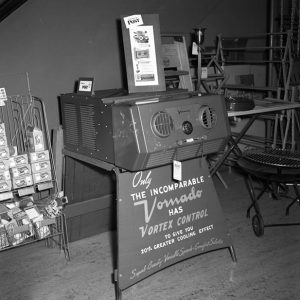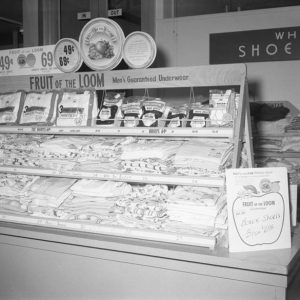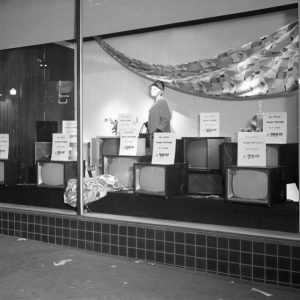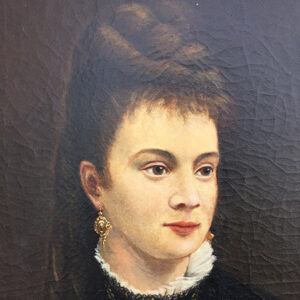calsfoundation@cals.org
Gustave (Gus) Blass (1849–1919)
Gus Blass was a Jewish immigrant who settled in Arkansas and became one of the state’s most successful merchants, establishing what became the largest department store in Arkansas, the Gus Blass Company.
Gustave (Gus) Blass was born on February 15, 1849, in Obornik, Germany, a small town north of Poznan, which is now part of Poland. At the age of sixteen, he boarded a ship bound for New York, identifying himself on the ship’s manifest as a merchant. After a short stint in Memphis, Tennessee, he made his way to Little Rock (Pulaski County), where he founded the Gus Blass Dry Goods Company in 1871.
The following year, Blass married Bertha Katzenstein, who was born in Cincinnati, Ohio. They had three children: Julian, Noland, and Essie. The couple was active in the Little Rock community, and Blass became president of the Concordia Club, a Jewish social club. Gus and Bertha Blass were philanthropists and figures in the social scene, often praised by the newspapers for their creative costumes at masked balls.
Blass had two brothers, Jacob and Louis, as well as a sister, Sophie Kempner, all of whom lived in Little Rock. Louis Blass and Max Heiman joined Gus Blass in the business, which became known as the Gus Blass Company. A brilliant marketer, Gus Blass was known as the “Merchant Prince.” The business expanded rapidly, becoming the largest and most successful department store in Arkansas.
Blass’s promotional flair took flight in the late 1800s, with the store hosting an extravagant grand-opening party each year. The event was described as a “fairyland,” with dramatic lighting effects and window displays featuring elaborate wax figures (early mannequins) draped in silk and lace garments. According to the Arkansas Gazette, more than 5,000 people attended the event in 1882, each receiving a keepsake box of chocolates as a party favor. In 1898, partygoers were regaled by Kuttner’s Orchestra, who played tunes such as “The Belle of New York” and John Philip Sousa’s “The Bride-Elect.” At the two-day event’s peak, the number of guests swelled to 25,000.
Blass embarked on three-week buying trips to New York each year, returning with the latest styles. In 1895, he met designer Madame Russell of New York and convinced her to come to Little Rock for a ladies’ reception in the store’s dress-making parlor. Russell arrived with the “endorsement of leading New York Society women.” “We did not rest until we secured her,” states an advertisement in the Arkansas Gazette, going on to note, “The markets of the East were ransacked by our buyers,” who were personally supervised by Russell and Blass. In turn, the company’s salesmen traveled throughout the area to make these “high class novelties in dress goods” available to buyers in smaller markets.
Sometime after the turn of the century, the store suffered a devastating fire, necessitating a move next door. Blass then commissioned local architect George R. Mann to design a seven-story building in the style of Chicago, Illinois, architect Louis Sullivan. When the new store opened in 1913, it was considered one of Little Rock’s first skyscrapers. The building, which still stands, is on the National Register of Historic Places.
Blass continued to run the business until his death on January 15, 1919; his son Julian then took over as president of the company, which eventually was sold and then merged with the Pfeifer company to become Pfeifer-Blass. The downtown store closed in the early 1970s, with a store opening in McCain Mall in North Little Rock (Pulaski County) for a few years before being replaced by Dillard’s in 1974. Gus Blass is buried in Oakland Cemetery in Little Rock.
For additional information:
Carolyn LeMaster Arkansas Jewish History Collection. Butler Center for Arkansas Studies. Central Arkansas Library System, Little Rock, Arkansas. Finding aid online at https://cdm15728.contentdm.oclc.org/digital/collection/findingaids/id/12765/rec/1 (accessed February 23, 2024).
“Gus Blass Department Store.” National Register of Historic Places nomination form. On file at Arkansas Historic Preservation Program, Little Rock, Arkansas. Online at http://www.arkansaspreservation.com/National-Register-Listings/PDF/PU0201.nr.pdf (accessed October 20, 2020).
“Gus Blass, Pioneer Merchant, Is Dead.” Arkansas Gazette, January 16, 1919, p. 1.
LeMaster, Carolyn Gray. A Corner of the Tapestry: A History of the Jewish Experience in Arkansas, 1820s–1990s. Fayetteville: University of Arkansas Press, 1994.
Kathy Alpert
PostMark Press, Inc.
 Business, Commerce, and Industry
Business, Commerce, and Industry Post-Reconstruction through the Gilded Age, 1875 through 1900
Post-Reconstruction through the Gilded Age, 1875 through 1900 ACF Logo
ACF Logo  Blass Department Store
Blass Department Store  Blass Store
Blass Store  Blass Store Clothing Display
Blass Store Clothing Display  Blass Store Display
Blass Store Display  Bertha Blass
Bertha Blass  Gus Blass Department Store
Gus Blass Department Store  Gus Blass
Gus Blass 




The Blass family sold the store to William Dillard in, I believe, 1963. Shortly thereafter, my grandfather sold the Pfeifer’s of Arkansas department store at 6th and Main (with a store in Hot Springs, too) to William Dillard. Mr. Dillard combined the store names for a short while as Pfeifer-Blass and a couple of years later changed the name to Dillard’s Department Stores as he continued to buy additional family-owned department stores across the South.